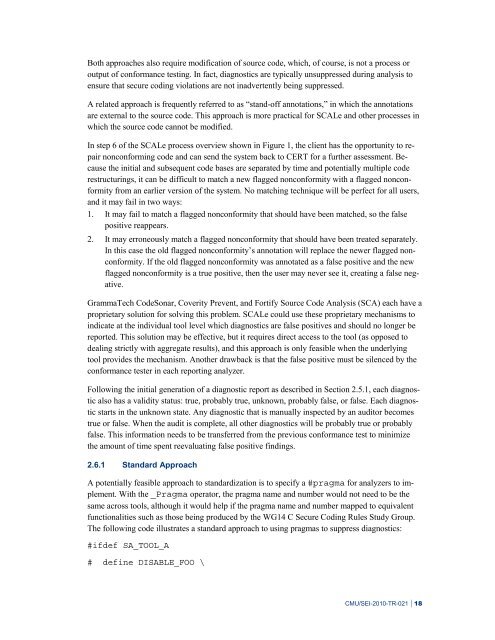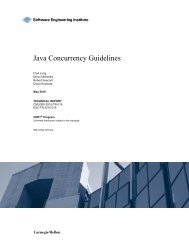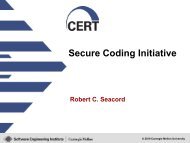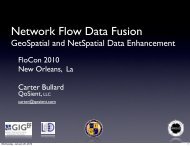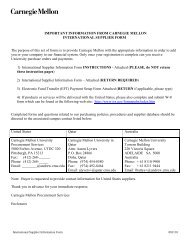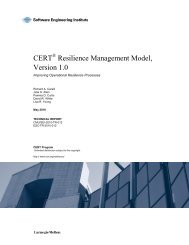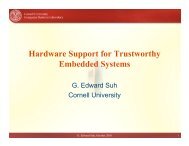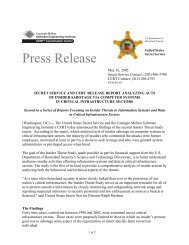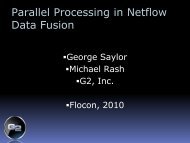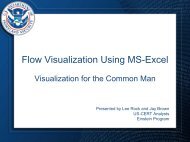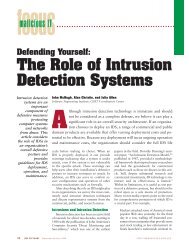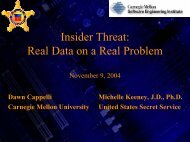Source Code Analysis Laboratory (SCALe) for Energy ... - CERT
Source Code Analysis Laboratory (SCALe) for Energy ... - CERT
Source Code Analysis Laboratory (SCALe) for Energy ... - CERT
Create successful ePaper yourself
Turn your PDF publications into a flip-book with our unique Google optimized e-Paper software.
Both approaches also require modification of source code, which, of course, is not a process or<br />
output of con<strong>for</strong>mance testing. In fact, diagnostics are typically unsuppressed during analysis to<br />
ensure that secure coding violations are not inadvertently being suppressed.<br />
A related approach is frequently referred to as “stand-off annotations,” in which the annotations<br />
are external to the source code. This approach is more practical <strong>for</strong> <strong>SCALe</strong> and other processes in<br />
which the source code cannot be modified.<br />
In step 6 of the <strong>SCALe</strong> process overview shown in Figure 1, the client has the opportunity to repair<br />
noncon<strong>for</strong>ming code and can send the system back to <strong>CERT</strong> <strong>for</strong> a further assessment. Because<br />
the initial and subsequent code bases are separated by time and potentially multiple code<br />
restructurings, it can be difficult to match a new flagged noncon<strong>for</strong>mity with a flagged noncon<strong>for</strong>mity<br />
from an earlier version of the system. No matching technique will be perfect <strong>for</strong> all users,<br />
and it may fail in two ways:<br />
1. It may fail to match a flagged noncon<strong>for</strong>mity that should have been matched, so the false<br />
positive reappears.<br />
2. It may erroneously match a flagged noncon<strong>for</strong>mity that should have been treated separately.<br />
In this case the old flagged noncon<strong>for</strong>mity’s annotation will replace the newer flagged noncon<strong>for</strong>mity.<br />
If the old flagged noncon<strong>for</strong>mity was annotated as a false positive and the new<br />
flagged noncon<strong>for</strong>mity is a true positive, then the user may never see it, creating a false negative.<br />
GrammaTech <strong>Code</strong>Sonar, Coverity Prevent, and Fortify <strong>Source</strong> <strong>Code</strong> <strong>Analysis</strong> (SCA) each have a<br />
proprietary solution <strong>for</strong> solving this problem. <strong>SCALe</strong> could use these proprietary mechanisms to<br />
indicate at the individual tool level which diagnostics are false positives and should no longer be<br />
reported. This solution may be effective, but it requires direct access to the tool (as opposed to<br />
dealing strictly with aggregate results), and this approach is only feasible when the underlying<br />
tool provides the mechanism. Another drawback is that the false positive must be silenced by the<br />
con<strong>for</strong>mance tester in each reporting analyzer.<br />
Following the initial generation of a diagnostic report as described in Section 2.5.1, each diagnostic<br />
also has a validity status: true, probably true, unknown, probably false, or false. Each diagnostic<br />
starts in the unknown state. Any diagnostic that is manually inspected by an auditor becomes<br />
true or false. When the audit is complete, all other diagnostics will be probably true or probably<br />
false. This in<strong>for</strong>mation needs to be transferred from the previous con<strong>for</strong>mance test to minimize<br />
the amount of time spent reevaluating false positive findings.<br />
2.6.1 Standard Approach<br />
A potentially feasible approach to standardization is to specify a #pragma <strong>for</strong> analyzers to implement.<br />
With the _Pragma operator, the pragma name and number would not need to be the<br />
same across tools, although it would help if the pragma name and number mapped to equivalent<br />
functionalities such as those being produced by the WG14 C Secure Coding Rules Study Group.<br />
The following code illustrates a standard approach to using pragmas to suppress diagnostics:<br />
#ifdef SA_TOOL_A<br />
# define DISABLE_FOO \<br />
CMU/SEI-2010-TR-021 | 18


